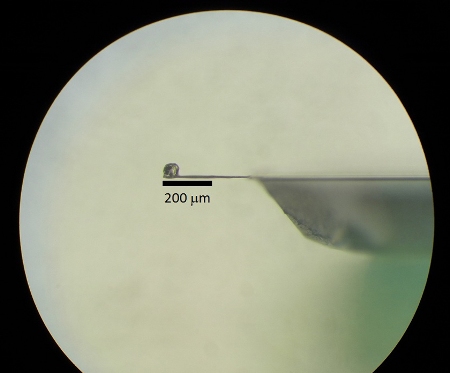Researchers from Rice University, the Japan Synchrotron Radiation Research Institute (JASRI), and Kyoto University have provided new insights regarding striking resemblances between the electronic properties of a recently discovered iron-based high-temperature superconductor (HTS) and its copper-based counterparts.
 This image shows a microscopic sample of a high-temperature superconductor glued to the tip of a cantilever. To study the magnetic properties of the sample, scientists applied a magnetic field and measured the torque that was transferred from the sample to the cantilever. (credit: Shigeru Kasahara/Kyoto University)
This image shows a microscopic sample of a high-temperature superconductor glued to the tip of a cantilever. To study the magnetic properties of the sample, scientists applied a magnetic field and measured the torque that was transferred from the sample to the cantilever. (credit: Shigeru Kasahara/Kyoto University)
When they studied the new iron-based HTS, the physicists discovered that the material’s electronic properties varied in the vertical and horizontal directions. They measured this electronic asymmetry at different temperatures, which include temperatures at which the material behaves like a superconductor. They also found this electronic asymmetry in materials that were doped in different ways. Doping is a chemical substitution process that enables both iron- and copper-based HTS materials to turn into superconductors.
The study results have been published in the journal, Nature. Andriy Nevidomskyy, co-author of the study, informed that this asymmetry is an illustration of collective electronic behavior due to quantum correlation between electrons.
Superconductivity takes place when electrons reach a quantum state, which enables them to freely flow via a material with no electrical resistance. It can happen only at extremely cold temperatures. However, two groups of layered metal compounds, for instance iron-based and copper-based, can achieve this phenomenon just above or short of −321° F. Researchers are still exploring the reasons behind high-temperature superconductivity.
One characteristic common between copper-based HTSs and iron-based cousins is electronic asymmetry or nematicity. In this latest work, the researchers provided the strongest proof so far regarding electronic nematicity in HTSs. In the research, they utilized barium iron arsenide. Phosphorous doping can covert this material into a superconductor. The temperature at which barium iron arsenide demonstrates superconductivity relies on phosphorus content. By altering the concentration of phosphorus and calculating electronic behavior at different temperatures, researchers can explore the reasons behind high-temperature superconductivity.
When cooled, an HTS material traverses a sequence of intermediate electronic phases until it reaches the superconducting phase. These changes can be observed using ‘phase diagrams,’ which depict the specific phase to be occupied by an HTS with respect to its chemical doping and temperature.
Referring to the line characterizing the limit of the nematic order, Nevidomskyy stated that this new proof confirms that nematicity occurs at all phases and not only in the region of the magnetic phase as believed earlier.
Another finding is the similarity between the phase diagram of the barium iron arsenide and that of copper-based HTSs, especially the close resemblance between the pseudogap in copper-based HTSs and the area for nematic order in the barium iron arsenide. These results may be helpful to physicists to identify whether electronic nematicity is required for HTSs.
Nevidomskyy plans to conduct similar studies on other types of iron-based HTSs. More research is required to identify whether correlated electron behavior has any role in the occurrence of the nematic order.